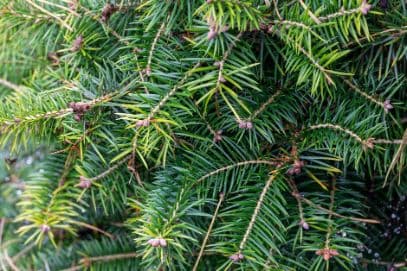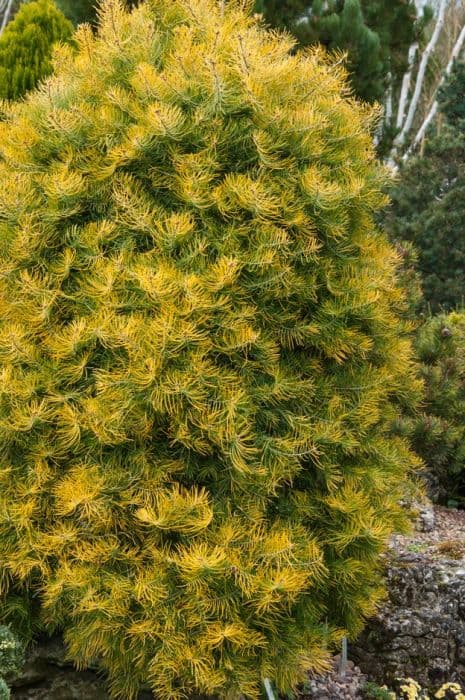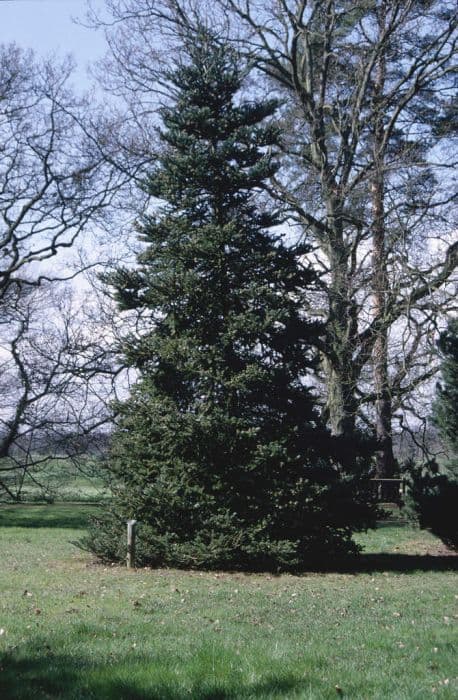Japanese Red Pine Pinus densiflora

ABOUT
The plant commonly known as Japanese red pine has a visually striking appearance, characterized by its reddish-brown bark that is often seen peeling off in flakes, lending it a rugged yet aesthetic look. The needles of this pine are slender and sharply pointed, typically growing in pairs which give the branches a somewhat fluffy texture. They exhibit a vibrant green color that contrasts beautifully with the reddish tinge of the branches. The shape of the Japanese red pine is generally quite symmetrical, with a conical crown that becomes more irregular as it matures, adding to its picturesque quality. Cones of the pine are oval and small, with a chestnut brown hue, hanging elegantly from the branches. During the blooming season, the tree may also show small, inconspicuous flowers, which tend to be yellowish. Although not highlighted in this description, it is worth mentioning that there can be variations in the appearance of individual trees based on environmental factors and age.
About this plant
 Names
NamesFamily
Pinaceae.
Synonyms
Japanese Red Pine, Korean Red Pine, Japanese Pine, Tanyosho Pine.
Common names
Pinus densiflora var. zhangwuensis, Pinus funebris, Pinus tatarinowii.
 Toxicity
ToxicityTo humans
The Japanese red pine (Pinus densiflora) is generally not considered toxic to humans. Ingesting parts of this plant, including needles or sap, does not typically result in poisoning. Most pines are safe and have even been used traditionally in some cultures for various purposes, including medicinal. However, consuming large quantities may cause gastrointestinal discomfort or irritation due to the high content of plant resins and oils.
To pets
The Japanese red pine (Pinus densiflora) is not specifically listed as toxic to pets. However, the needles of pine trees can be mildly toxic and may cause irritation or gastrointestinal distress if ingested in large quantities. Symptoms of pine needle ingestion in pets can include vomiting, diarrhea, lethargy, or abdominal pain. It is always best to prevent pets from ingesting plant material.
 Characteristics
CharacteristicsLife cycle
Perennials
Foliage type
Evergreen
Color of leaves
Green
Height
15-30 feet (4.6-9.1 meters)
Spread
15-25 feet (4.6-7.6 meters)
Plant type
Tree
Hardiness zones
3-7
Native area
Japan
Benefits
 General Benefits
General Benefits- Landscaping and Ornamental Value: Japanese Red Pine adds aesthetic appeal to gardens and parks due to its distinctive bark and graceful foliage.
- Erosion Control: Its root system stabilizes soil and helps prevent erosion on slopes and hillsides.
- Habitat for Wildlife: Provides shelter and food for birds, insects, and small mammals within its natural range.
- Shade Provider: Offers shade and cooler temperatures beneath its canopy, creating comfortable outdoor spaces.
- Timber Production: Wood is used for construction, furniture, and craftwork because of its strength and durability.
- Cultural Significance: Holds importance in various cultural traditions and practices, often featuring in East Asian art and garden design.
 Medical Properties
Medical Properties- Antimicrobial: Pinus densiflora extracts may have antimicrobial effects against certain bacteria and fungi.
- Anti-inflammatory: Compounds in the tree's resin or extracts might help reduce inflammation in some contexts.
- Antioxidant: The tree may contain antioxidants that help in protecting cells from damage by free radicals.
 Air-purifying Qualities
Air-purifying QualitiesThis plant is not specifically known for air purifying qualities.
 Other Uses
Other Uses- Japanese Red Pine's bark extract is used in the tanning industry for processing leather, utilizing its preservative properties and tannic acid content.
- The resin from Pinus densiflora is used to create a waterproofing material, primarily in traditional boat-making practices.
- Wood shavings and sawdust from Japanese Red Pine can serve as mulch in gardens, providing nutrients and preventing weed growth.
- Juvenile foliage of the Japanese Red Pine is occasionally used to create decorative wreaths and other festive ornaments during holidays.
- Ink for traditional East Asian calligraphy has been made using soot from the burnt wood of Pinus densiflora, known for its deep black pigment.
- The pine nuts from Pinus densiflora can be used as a natural deterrent against clothes moths when placed in wardrobes or drawers.
- Pine cones from the Japanese Red Pine are sometimes used for biomass fuel, offering an alternative energy source.
- Pinus densiflora wood is utilized in train track construction, particularly for railway sleepers due to its resilience and longevity.
- Historically, the wood and needles of Japanese Red Pine were used to make a natural dye for fabrics, yielding a range of earthy tones.
- The fine wood dust of Pinus densiflora is sometimes incorporated into ceramics glaze for unique textures and wood-ash effects on pottery.
Interesting Facts
 Feng Shui
Feng ShuiThe Japanese red pine is not used in Feng Shui practice.
 Zodiac Sign Compitability
Zodiac Sign CompitabilityThe Japanese red pine is not used in astrology practice.
 Plant Symbolism
Plant Symbolism- Longevity: The Pinus densiflora, commonly known as Japanese Red Pine, is renowned for its long lifespan, which is often seen to symbolize endurance, perseverance, and the continuation of life beyond generations.
- Resilience: This pine species is adaptable and can thrive in difficult conditions, representing the ability to withstand adversity and remain steadfast in the face of challenges.
- Vitality: With its vibrant red bark and green needles that remain throughout the year, the Japanese Red Pine is a symbol of vigorous health and vitality.
- Immortality: In some cultures, pine trees are thought to hold the secret to eternal life, possibly because they seem evergreen and unchanging through the seasons, with the Japanese Red Pine being no exception.
 Water
WaterJapanese Red Pine prefers to be watered deeply and infrequently. Check the topsoil—if it's dry to the touch about 2 inches deep, it's time to water. Generally, watering once a week during dry periods with about 1 to 2 gallons of water is sufficient for young trees. Mature trees will require less frequent watering, depending on the weather and soil conditions. Avoid waterlogging by ensuring good drainage around the tree's location.
 Light
LightJapanese Red Pine thrives in full sunlight. It's best to place it in a location where it can receive at least six hours of direct, unfiltered daylight per day. Avoid shaded areas, as this tree prefers to be in the open sun with good air circulation.
 Temperature
TemperatureJapanese Red Pine can tolerate a range of temperatures, generally from 20°F to 60°F without significant damage. It handles cold well and can survive brief dips even lower, while its ideal growing conditions are between 50°F and 70°F.
 Pruning
PruningPrune Japanese Red Pine to maintain its shape and health, and to remove any damaged or diseased branches. The best time for pruning is late winter or early spring, before new growth starts. Pruning is generally only necessary once a year, unless you are shaping the plant or controlling its size.
 Cleaning
CleaningAs needed
 Soil
SoilJapanese red pine prefers well-draining, acidic soil with a pH ranging from 4.5 to 6.0. A mixture of peat, pine bark, and sand or perlite in equal parts is ideal to provide the necessary drainage and acidity.
 Repotting
RepottingJapanese red pines require repotting every 2 to 3 years to prevent root-bound conditions and renew soil nutrients.
 Humidity & Misting
Humidity & MistingJapanese red pine thrives in average outdoor humidity levels; it is not particular about high humidity and can tolerate dry conditions.
 Suitable locations
Suitable locationsIndoor
Ensure bright light, cooler temps, and good air flow for indoor Japanese red pine.
Outdoor
Plant in sunny spot with well-drained soil; protect from harsh winds.
Hardiness zone
3-7 USDA
 Life cycle
Life cycleThe Japanese red pine (Pinus densiflora) begins its life cycle when seeds are dispersed from mature cones, often carried away by wind or animals. Upon landing in suitable soil, the seeds germinate to produce seedlings, given there is enough sunlight, moisture, and proper temperature. These seedlings grow into saplings, developing a root system and beginning photosynthesis as they produce needles. As saplings mature into adult trees, they develop thicker trunks, a more extensive branch system, and begin to produce cones after a few years, typically when they reach 10 to 15 years of age. Pollination occurs in the spring, with male cones releasing pollen that is carried by the wind to female cones, where fertilization happens and seeds develop. Completing the cycle, mature trees that are well-established continue to grow and produce cones for many years, contributing to the survival and propagation of the species.
 Propogation
PropogationPropogation time
Spring to Summer
The Japanese red pine, Pinus densiflora, is most commonly propagated through seeds. The ideal time for sowing seeds is in the fall, allowing the cold stratification period to occur naturally over the winter months. For successful propagation, seeds need to be stratified at 33-40°F (1-4°C) for a period of 60-90 days to break dormancy prior to sowing in the spring. Once stratified, seeds are sown in well-drained soil and covered lightly with a fine layer of soil. Seedlings generally require ample sunlight and should be watered regularly but not excessively, as Japanese red pine prefers drier conditions. It may take several years for the seedlings to grow large enough to be transplanted into their permanent location. Seed propagation is a slow process but is effective for producing true-to-type plants.









